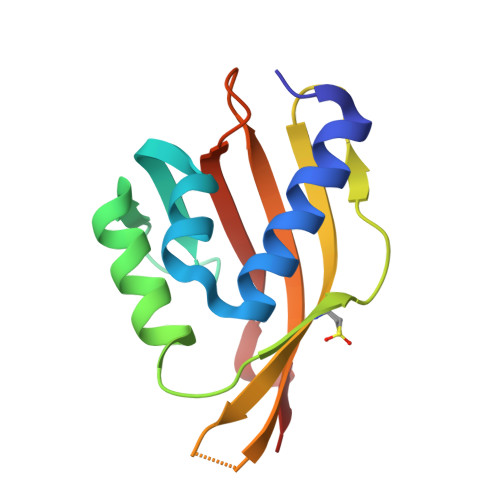A tale of two isomerases: compact versus extended active sites in ketosteroid isomerase and phosphoglucose isomerase.
Somarowthu, S., Brodkin, H.R., D'Aquino, J.A., Ringe, D., Ondrechen, M.J., Beuning, P.J.(2011) Biochemistry 50: 9283-9295
- PubMed: 21970785
- DOI: https://doi.org/10.1021/bi201089v
- Primary Citation of Related Structures:
3SED - PubMed Abstract:
Understanding the catalytic efficiency and specificity of enzymes is a fundamental question of major practical and conceptual importance in biochemistry. Although progress in biochemical and structural studies has enriched our knowledge of enzymes, the role in enzyme catalysis of residues that are not nearest neighbors of the reacting substrate molecule is largely unexplored experimentally. Here computational active site predictors, THEMATICS and POOL, were employed to identify functionally important residues that are not in direct contact with the reacting substrate molecule. These predictions then guided experiments to explore the active sites of two isomerases, Pseudomonas putida ketosteroid isomerase (KSI) and human phosphoglucose isomerase (PGI), as prototypes for very different types of predicted active sites. Both KSI and PGI are members of EC 5.3 and catalyze similar reactions, but they represent significantly different degrees of remote residue participation, as predicted by THEMATICS and POOL. For KSI, a compact active site of mostly first-shell residues is predicted, but for PGI, an extended active site in which residues in the first, second, and third layers around the reacting substrate are predicted. Predicted residues that have not been previously tested experimentally were investigated by site-directed mutagenesis and kinetic analysis. In human PGI, single-point mutations of the predicted second- and third-shell residues K362, H100, E495, D511, H396, and Q388 show significant decreases in catalytic activity relative to that of the wild type. The results of these experiments demonstrate that, as predicted, remote residues are very important in PGI catalysis but make only small contributions to catalysis in KSI.
Organizational Affiliation:
Department of Chemistry and Chemical Biology, Northeastern University, Boston, Massachusetts 02115, United States.















